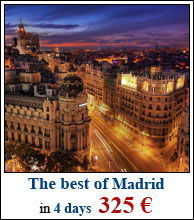 |
Spain | Travel | Regions | Cities | Coasts | Islands | Culture |
| Spain / Madrid / Sightseeing |
|
| More Information | ||
| Plan your Trip | ||
| ||||||
The Medieval MadridWe start our walk in Barrio de la Morería, where the Moors had their law-court, and arrive from here to three squares which characterize the medieval Madrid: Plaza de la Paja, the commercial center of this epoch, Plaza de San Andrés and Plaza de Cruz Verde.Of particular interest are the Mudejar-style buildings, as the church of San Nicolás de los Servitas, the tower San Pedro el Viejo and finally Casa de los Lujanes at Plaza de la Villa. The Madrid of the Habsburg-Epoch "El Madrid de los Austrias" is how Spaniards call the part of the city that was blooming when Spain belonged to the Habsburg-Empire. Under King Charles I, at the same time Charles V of the German Empire and the first of his family to reign Spain, the importance of Madrid grew, but it was Philip II who made it the capital. To visit the buildings of this epoch, mainly in Renaissance- and Baroque-styles, is perhaps among the most impressive Madrid has to offer:
"El Madrid de los Austrias" is how Spaniards call the part of the city that was blooming when Spain belonged to the Habsburg-Empire. Under King Charles I, at the same time Charles V of the German Empire and the first of his family to reign Spain, the importance of Madrid grew, but it was Philip II who made it the capital. To visit the buildings of this epoch, mainly in Renaissance- and Baroque-styles, is perhaps among the most impressive Madrid has to offer: Our tour starts at Puerta del Sol, in the very center of town. Passing through some narrow streets we arrive to the Descalzas Reales, to the Monastery de la Encarnación, Palacio de Uceda, and, through Calle Mayor, to Plaza de la Villa, a beautiful square with interesting buildings: Casa de la Villa, Casa Cisneros and Tower of Lujanes. Just behind there is one of the best-known and most impressive squares of Madrid, Plaza Mayor, with Casa de la Panadería, an old bakery, and Casa de la Carnicería, an old butchery, as mayor attractions. In the center of the square there is a statue of Philip III. Other buildings worth visiting in this part of town are the Cathedral of San Isidro, the Ministry of Foreign Affairs Madrid under the BourbonsWhen the Bourbon family took over the Spanish crown, Madrid grew to its actual importance. The Royal Palace, Palacio Real, was built in that epoch. To have a walk through through the Bourbons' Madrid you should start again at Puerta del Sol, where you find the remarkable old post.office, Casa de Correos. Walking along Calle Alcalá, one of the most important boulevards of Madrid, you arrive to Casa de Postas, another old post-office, and Real Casa de Aduanas, the Royal Customs Office.In the Academy of Arts there is a café with extraordinarily beautiful decoration - maybe a reason to interrupt your sightseeing-trip for a moment, although not only your cup of coffee but alone to enter costs money here ... Having taken some refreshment, now you will be in the mood to visit the Oratorio del Caballero de Gracia, a chapel that is considered a masterpiece of neoclassic architecture. Where the streets Calle Alcalá and Gran Via cross, you find the splendid 18th century baroque church Iglesia de San José, and later, at the crossing with Cibeles there is the Palace of Buenavista, built 1777 for the Duke of Alba. From here you may either continue on Calle Alcalá and arrive to the triumphal arch of Puerta de Alcalá, or follow Paseo del Prado with its beautiful fountains of Cibeles, Apollo and Neptune, the Botanical Gardens and the Astronomical Observatory. The Madrid of 19th CenturyIn this epoch many parts of Madrid were modified fundamentally, specially by Joseph Bonaparte, who after his brother Napoleon had conquered Spain took over the government and wanted to build in the center of Madrid a wide boulevard in the style of Paris' Champs Elysées. The square Plaza de Oriente with the Teatro Real, Madrid's opera house, were created then. His projects were stopped by Napoleon's final defeat.From Plaza de Oriente you pass (once more) Puerta del Sol and arrive to Calle del Prado, with the Palacio de Congresos, Teatro de la Zarzuela and Banco de España. Museo del Prado needs to be visited with time, as it includes one of the great Museums of Arts in the world. Parque del Retiro The Madrid of 20th CenturyAt Paseo de la Castellana you find the most impressive works of this century:The beautiful gardens Jardines del Descubrimiento at Plaza de Colón, with a big statue of Christopher Columbus, who by the way is called Cristobal Colón in Spanish (now you know who gave his name to all the square). Centro Cultural de la Villa is a cultural center that organizes concerts and other performances each night. More up the Castellana there are several interesting examples of modern architecture: Torres de Colón, Edificio de la Unión y el Fenix, Bankunión, La Adriatica, Compañía de Seguros de Occidente, La Caixa, and the Palace of Congresses and Expositions. The Open Air Sculpture Museum is certainly worth visiting as well. Among the more interesting works from between 1980 and 1990 are the Fish Market of Puerta de Toledo, the redesigned Train Station of Atocha, the Centro de Arte Reina Sofia, the Windsor-Tower, erected over the base of other buildings, the Torre Picasso by Japanese architect Yamasaki of a height of 150 meters, Edificio Sollube and the impressive Torre Europa. Another all but different sight of Madrid that you should not miss is the gigantic flea-market, El Rastro |